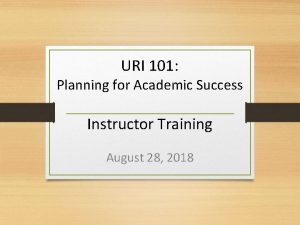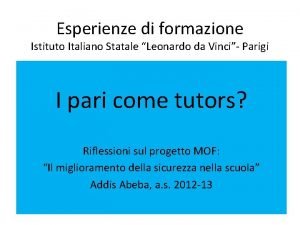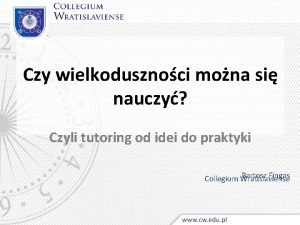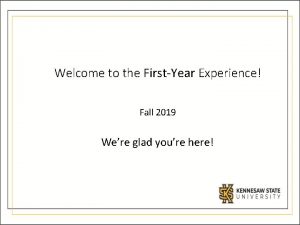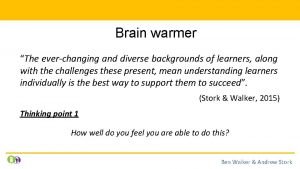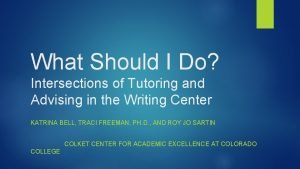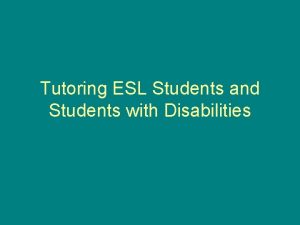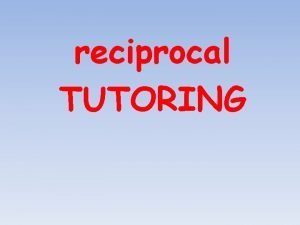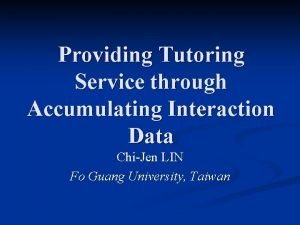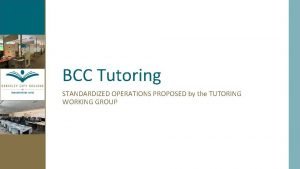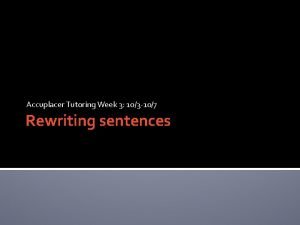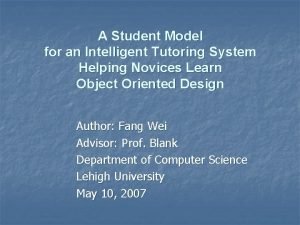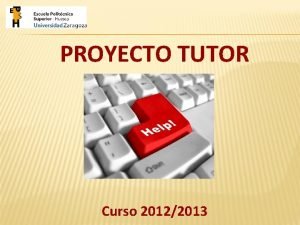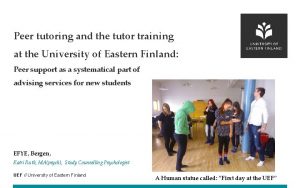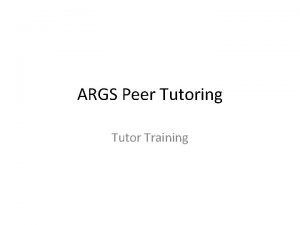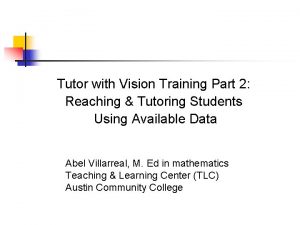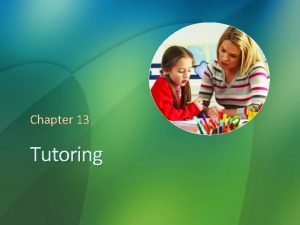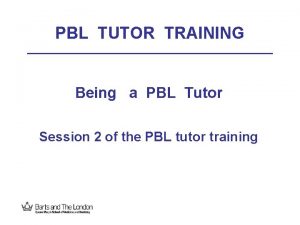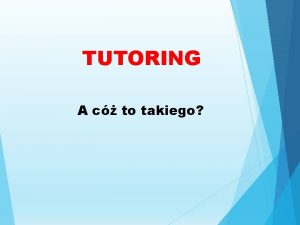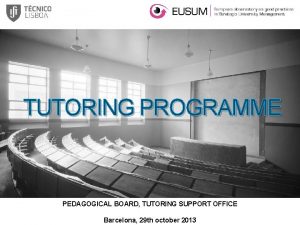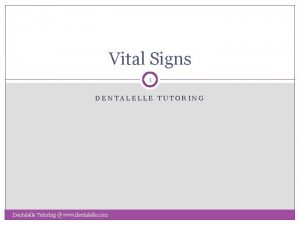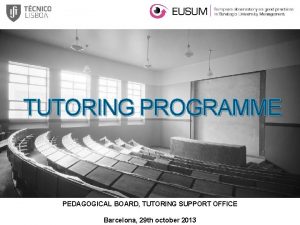Tutor Training and Certification Importance of Academic Tutoring
















- Slides: 16

Tutor Training and Certification • Importance of Academic Tutoring • Advantages CRLA Certification (http: //www. clra. net) • Tutoring Best Practices • Active vs. Passive Learning • Questioning Technique • Difficult Tutoring Situations • Learning Styles • Effective Tutoring Techniques

Tutoring Best Practices 1. Remain student centered. 2. Do not re-lecture on the content or simply answer questions. Rather, you should facilitate learning. 3. Encourage student participation at all times. 4. Keep up to date in your subject area. 5. Help students find their answers by referring them to their lecture notes and textbooks. (You are not the instructor; you are supplementing the instructor’s presentation). 6. Clarify concepts that students have attempted to UNDERSTAND and have READ. 7. Listen to students’ concerns both academic and personal, but refer them to others who are in position to help. Keep this information private.

Active Versus Passive Learning • Passive Learning: (Tutor): Here, let me show you how to do that. • Active Learning: (Tutor): What section of the textbook discusses this?

Active Versus Passive Learning Passive is when. . . • The Tutor lectures or explains without engaging the Student with questions. • The Tutor answers the student’s questions rather than asks the Student to call upon prior knowledge, or to consult lecture notes, textbook, and other reference materials. • The Tutor completes the assignment rather than asks the Student to do it. Active is when. . . • The Student participates in learning to gain mastery of the material. • Tutors foster active learning by structuring activities that require Students to do the work, allowing them to become more independent learners.

Questioning Techniques Ask the right questions in order to involve Tutees in the session. Some types of questions should be avoided: 1. Complex Questions: Ask questions one at a time and as simply as you can, giving tutees time to think and organize their thoughts without confusing them. 2. Leading Questions: Encourage the tutees to come up with the answer by thinking on their own instead of leading them in the direction that you want them to go. 3. Yes or No Questions: Leave the question open so that the tutee has to ‘fill in the blank’, not just provide a yes or no answer.

Difficult Tutoring Situations Motivating Students • Talk about what is expected of them. Explain what you would like to see them accomplish within a given period of time Help them find the resources they need to accomplish this. • Let them know that if they bring their work to you, you can give them feedback as to how they are doing. • Recognize good work by praising the student. They need to know when they have met or exceeded the performance standard. • Request their input. Have them express ways that they could better accomplish the tasks set out before them.

Preventing Frustration Do: • Give the student adequate time to come up with his/her own answer. • Establish a rapport with the student. • Stay calm. • Be actively friendly, genuine, and helpful. • Recognize the student’s nonverbal expressions. • Give students options (different study techniques, different resources) Don’t: • Overreact or lose patience. • Try to get involved in a power struggle. • Make false promises. • Belittle the student.

Learning Styles • The following website demonstrates different types of learning styles that should be recognized during tutoring sessions. http: //www. vark-learn. com/english/index. asp • • Visual Aural Read/Write Kinesthetic

Learning Styles Provide students with ways to improve their learning using their particular learning style. • • • Use different colored markers and pens (visual) Use headphones (aural) Use Concept mapping (visual) Provide or make flash cards (read/write) Use gestures while speaking (kinesthetic) Underline/highlight (read/write) Use symbols/white space (visual) Use outlines (read/write) Tape record lectures for later playback (aural)

Tutoring Techniques Understanding the Role of the Tutor 1. Coach (not the instructor) 2. Tutor/Guide

Tutoring Techniques Using Positive Reinforcement 1. Verbal and nonverbal components 2. Should be varied 3. Should be increased when the student is uncertain 4. Should be used when students are partially correct

Tutoring Techniques Practicing Effective Listening Skills 1. Wait for Student Questions 2. Wait for Student Response after Asking Questions 3. Correctly Interpret Verbal and Nonverbal Messages 4. Respond to Feelings 5. Listen Patiently 6. Don’t Interrupt 7. Provide Delayed Positive Reinforcement

Tutoring Techniques Promoting Students’ Ideas 1. Acknowledge the Student’s Ideas 2. Encourage Student’s Ideas 3. Actively Listen-Respond to Ideas 4. Redirect the Student’s Question 5. Yield to the Student’s Ideas 6. Build on the Student’s Ideas

Tutoring Techniques Utilizing Student Verbalization 1. Gives Session a Conversational quality 2. Clarifies thinking 3. Helps Students Focus on Learning Problems 4. Produces More Student Questions 5. Helps Students Answer Own Questions or Catch Mistakes 6. Helps Tutor Diagnose Learning Difficulties 7. Improves Student Confidence

Tutoring Techniques Practicing Effective Questioning Skills 1. Use Open-ended Questions 2. Use Appropriate Levels of Questioning • Memory Level • Comprehension Level • Application Level 3. Use Socratic Questioning (more than one "correct" answer, and more often, no clear answer at all )

Tutoring Techniques Reinforcing Independent Learning 1. Let the Student Do the Work 2. Use Appropriate Amount of Structure 4. Discuss Note Taking Strategies 5. Discuss Test-Taking Strategies 6. Refer to the Lecture and the Lecture Notes 7. Refer to the Text and Other Resources 9. Encourage Use of Campus Resources
 Cern academic training
Cern academic training Pressure force and area
Pressure force and area Uri 101
Uri 101 Smarty cats tutoring
Smarty cats tutoring Istituto leonardo da vinci parigi
Istituto leonardo da vinci parigi Tutoring definicja
Tutoring definicja Ksu cse 1321 lab final
Ksu cse 1321 lab final Scholarly tutoring
Scholarly tutoring Stanford computer science department
Stanford computer science department Tutoring
Tutoring Tutoring
Tutoring Msi tutoring ucsc
Msi tutoring ucsc Mutuo insegnamento esempio
Mutuo insegnamento esempio Tutoring
Tutoring Elisabeth chemouni
Elisabeth chemouni Accuplacer tutoring
Accuplacer tutoring Tutoring
Tutoring


